Caring for your axolotl means that you are catering to its every needs. And the very first of its needs that you need to satisfy is their hunger. Now, axolotl have a delicate diet.
There are certain things it can eat, and other things it can’t. But one thing you can surely feed is bloodworms.
Bloodworms are one of the pet foods that have a significant presence in baby & young axolotls’ food. They help your little buddies to grow fast. Additionally, their small size makes them easy to swallow & digest. While adults can eat bloodworms as their side dish.
In this article, I will break down everything about do axolotls eat bloodworms to portray a bigger picture that would benefit you as an axolotl owner.
Can I feed my axolotl bloodworms?

Bloodworms are one of the top-notch foods for a pet axolotl, I even included them in my article on foods that an axolotl can eat. These sandy creatures are found in sandy silt and also in coastal salt water. It’s not surprising to see them in the deep soil of your backyard.
Bloodworms are carnivorous animals that need animal protein to carry on their lives. As they live on protein, they are loaded with a huge amount of protein though the size is little.
Can axolotls eat live bloodworms?
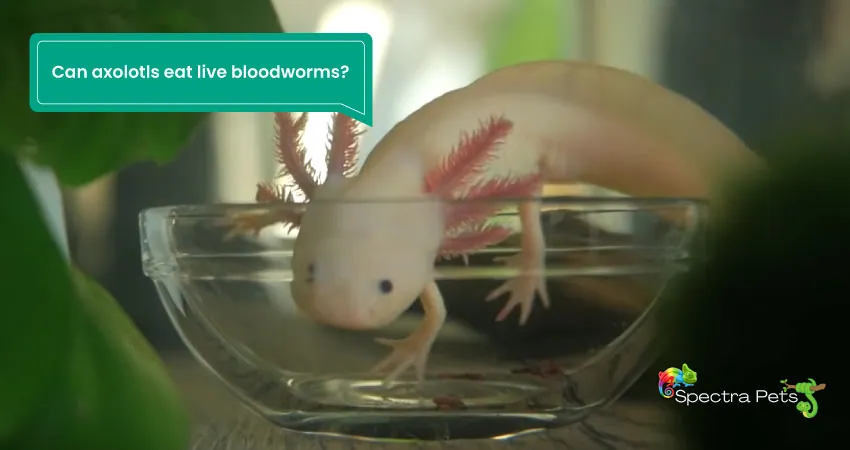
Like any other animal, an axolotl will find it most enjoyable to eat live bloodworms. However, storing bloodworms is a bit difficult, unlike frozen and dry bloodworms.
Plus, you can’t store these mini critters for a long time because they will die soon. So you must prepare your mind to get them and feed them instantly without any delay to your axolotl.
In addition to that, it’s crucial to get live bloodworms from a reputable aquatic pet supply shop. Because it will increase the chance of buying bloodworms that are free from diseases and parasites.
Every time before feeding the live bloodworm to the axolotl, you should wash them very well to remove any remaining sand, chemicals, or contaminants. The best thing about feeding live bloodworms to your axolotls is that they are loaded with nutrients that boost the growth of your exotic pet.
Not only that, it ignites the snapping & hunting mood of your lovely axolotl.
Can axolotls eat frozen bloodworms?
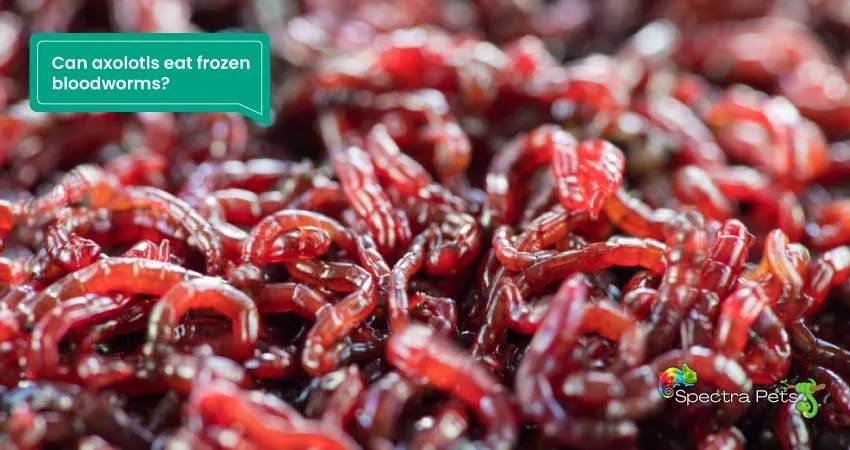
Without any doubt, frozen bloodworms can be a good option as a side dish for the adult axolotl & a staple food for young axolotls. This type of bloodworm is easy to store & feed. Usually are found in small red square shapes. After purchasing them you can store them around for 6 months.
Every time you want to treat your axolotl with this thing, you need to defrost them first. Sadly the amount of nutrition in this one is much less than the live bloodworms.
Can axolotls eat freeze-dried bloodworms?
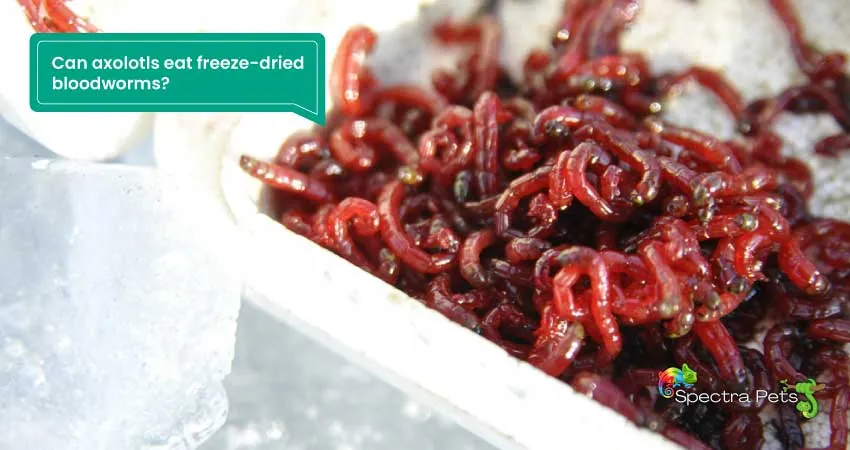
Yes, axolotls will eat freeze-dried bloodworms but there is a big problem in feeding this item. This food lacks nutritional value compared to the live one so you will see less result from feeding this.
While feeding freeze-dried bloodworms, you have to first let them be soft enough to make them eatable for your axolotl. Then using your hand or tong you can feed your pet.
How much bloodworms to feed to axolotl?
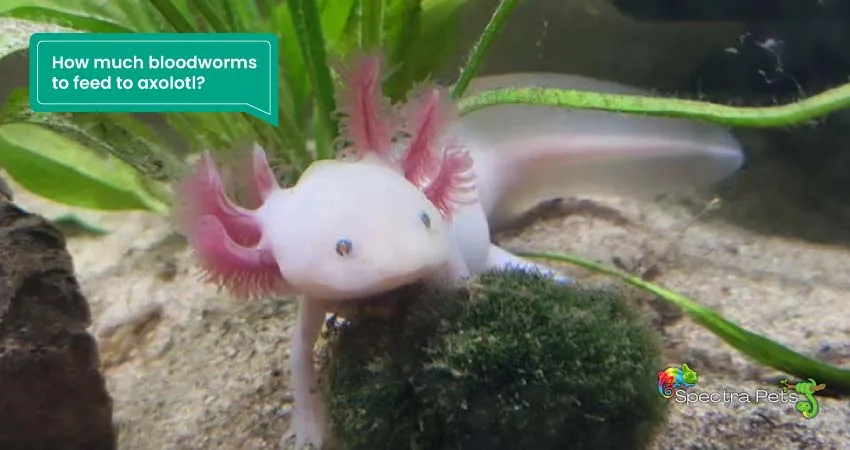
Though bloodworms are a reliable source of nutrients, it’s not a superfood that would give backup for what your axolotl will get from other food sources. There has to be a specific percentage of bloodworms in your axolotl diet.
Too much bloodworm feeding will turn your axolotl into a pet that would most likely show no interest in the rest of its regular meals.
Another thing is that the amount of bloodworm feeding to axolotl needs to be changed as they grow from small age to adulthood.
Newborn to Juvenile axolotl
For older juvenile axolotl that has a size from 4-8,’’ you can give them once a week because they will have other foods like mealworms, earthworms, and pellets in their list.
It’s common for the newborn axolotl and the younger one to get triggered easily by the movement in the water. For these little fellas, movements mean the food is almost close to their mouth.
Usually, baby axolotls have body sizes of around 0.5’’ so bloodworms are one of the best picks for them. Bloodworm average size is close to 0.2-1’’ which makes the swallowing process very easy for the baby axolotl.
Moreover, young axolotls need to be fed daily, so you can feed them bloodworms with a little gap of 2–3 days. For best health & growth, feed your baby axolotl the maximum number of bloodworms for 2–3 minutes.
From the frozen bloodworms, you can take a small piece and feed them to your baby axolotl. The chunk of the frozen bloodworms has to be tiny, or it will turn into overfeeding. For 4’’ axolotl, you can give 1 cube of bloodworms daily.
Read More: What to feed Juvenile Axolotls
Adult axolotl
Along with their regular food like mealworms, and pellets, you can treat them with bloodworms as a side food. In terms of amount, there is no hard & fixed rule but the number of bloodworms can be 5-10 for adults.
Another way you can feed them is to give them bloodworms for 2-3 minutes continuously and then stop.
Can axolotls eat bloodworms every day?
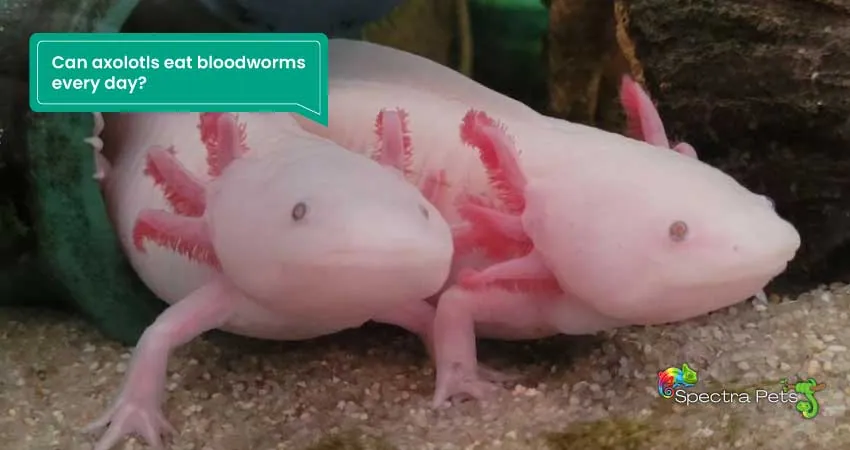
Not all axolotl can eat bloodworms every day. Only the younger axolotl can eat bloodworms every day because they need multiple feeding per day.
And bloodworm size is highly suitable for their feeding.
Safety tips for feeding bloodworms to axolotl
Most of the time there would be no problem but still, there are risks in feeding bloodworms to axolotl. During the first few days of axolotls’ young stage, it can have a bit of complications swallowing these worms.
So you must ensure that you are giving them smaller size bloodworms.
Bloodworms have microorganisms that can stay in the tank water. These little organisms make their way to axolotl gills and make breathing harder. So, you should change the water frequently after giving bloodworms as feed.
Adding to that, always monitor if your adult or young axolotl is eating all the bloodworms or not. Because of any leftover bloodworms, even the dead ones can turn the tank water quality bad. When water quality deteriorates, it can seriously harm your exotic pet. If you notice any uneaten bloodworm remove it immediately.
Bloodworms often get stuck into young or baby axolotls’ gills which can be fatal, so please try to avoid such a situation if you want your pet to live long. For that, you can feed them the bloodworms one by one using a tong.
Final words
We hope you now have a better understanding of how much bloodworms should be in the diets of axolotls.
As long as you can maintain safety during feeding bloodworm to axolotl and feed in a balanced way, you can expect the healthy growth of your axolotl.
If this short writing helps you as a passionate axolotl lover, then it would be worth it. I hope it helps you a lot.
